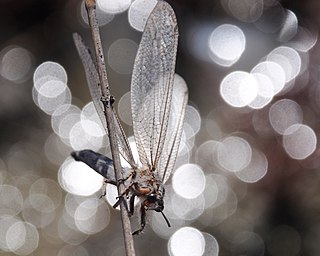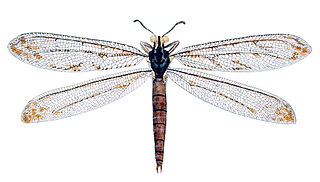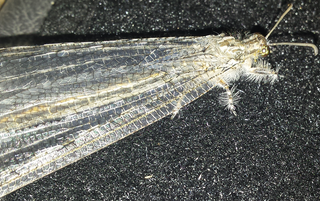
The insect order Neuroptera, or net-winged insects, includes the lacewings, mantidflies, antlions, and their relatives. The order consists of some 6,000 species. Neuroptera can be grouped together with the Megaloptera and Raphidioptera in the unranked taxon Neuropterida including: alderflies, fishflies, dobsonflies, and snakeflies.

The antlions are a group of about 2,000 species of insect in the neuropteran family Myrmeleontidae, known for the fiercely predatory habits of their larvae, which in many species dig pits to trap passing ants or other prey. The adult insects are less well known, due to their relatively short lifespans compared to the larvae. Adults mostly fly at dusk or after dark, and may be mistakenly identified as dragonflies or damselflies; they are sometimes known as antlion lacewings. In North America, the larvae are sometimes referred to as doodlebugs because of the strange marks they leave in the sand.

Ascalaphidae is a family of insects in the order Neuroptera, generally called owlflies. They are fast-flying crepuscular or diurnal predators of other flying insects, and have large bulging eyes and strongly knobbed antennae. The larvae are ambush predators; some of them make use of self-decoration camouflage.

The Neuropterida are a clade, sometimes placed at superorder level, of holometabolous insects with over 5,700 described species, containing the orders Neuroptera, Megaloptera, and Raphidioptera (snakeflies).

Acanthaclisini is a tribe in the antlion subfamily Acanthaclisinae.
Glenurus luniger is a species of antlion in the family Myrmeleontidae. It is found in Central America and North America.

Glenurus is a genus of antlions in the family Myrmeleontidae. There are about 12 described species in Glenurus.

Vella is a genus of antlions in the family Myrmeleontidae. There are about five described species in Vella.

Dendroleon is a genus of antlions in the family Myrmeleontidae. There are more than 20 described species in Dendroleon.
Paranthaclisis is a genus of antlions in the family Myrmeleontidae. There are five described species in Paranthaclisis.

Vella fallax is a species of antlion in the family Myrmeleontidae. It is found in the Caribbean Sea, Central America, North America, and South America.
Speleon is a genus of cave-dwelling antlions, that is, the genus belongs to the family Myrmeleontidae.
Newleon is a genus of cave-dwelling antlions, that is, the genus belongs to the family Myrmeleontidae.
Froggattisca is a genus of cave-dwelling antlions, that is, the genus belongs to the family Myrmeleontidae.
Froggattisca kakadu is a species of cave-dwelling antlions.
Froggattisca rennerensis is a species of cave-dwelling antlion, endemic to the Northern Territory.
Froggattisca testacea is a species of cave-dwelling antlion, endemic to the Northern Territory.
Froggattisca anicis is a species of cave-dwelling antlion, endemic to the Northern Territory and Western Australia.
Froggattisca gemma is a species of cave-dwelling antlion, endemic to Queensland and Western Australia.
Froggattisca radiostriata is a species of cave-dwelling antlion, endemic to Queensland and Western Australia.








